Coto Research Center: Athletics goes Digital
What is happening here, in essence, is that the scientific tools of biomechanics and computer technology are being applied to human and animal
By PSA in PSA Magazine on Sunday, May 2, 1982
Coto Research Center: Athletics Goes Digital
The Coto Research Center, located in Orange County, California, is a state-of-the-art sports research facility. The center, a $1.2-million project started by Dr. Gideon Ariel, a Ph.D. and former Olympian, and Vic Braden, one of America's premier tennis teachers, uses biomechanics and computer technology to analyze and improve athletic performance.
The center uses a process known as "digitizing" to record an athlete's movements at up to 10,000 frames per second. The data is then analyzed by a computer, which produces a printout comparing the athlete's performance to the "theoretically perfect" way to perform that particular movement. The athlete then works with Ariel and his staff to improve their performance.
The center also features the Wilson Ariel 4000, a computer-controlled exercise machine that can monitor an individual's physical status, ability, and progress while exercising. Ariel believes that the machine's instant feedback ability will have far-reaching applications in athletics and rehabilitation.
The center's services are available to the public, but at a cost of $2,500 per person. The center also conducts experiments for various sports equipment manufacturers.
Tip: use the left and right arrow keys
MAY 19
WEEKEND GETAWAYS: THE WEST'S TOP TRAVEL WRITERS REVEAL THEIR FAVORITE RETREATS
SPOR S
COTO RESEARCH CENTER: ATHLETICS GOES DIGITAL
America's premier tennis teachers.
What is happening here, in essence, is that the scientific tools of biomechanics and computer technology are being applied to human and animal
printout that compares the subject's performance to the "theoretically perfect" way to perform that particular movement. The athlete then sits down with Ariel and members of his staff in an attempt to discover what must be done to perform consistently at the athlete's full potential.
"Human beings are creative, but we have terrible memories," says Ariel, a stocky Israeli who competed as a discus thrower and shot putter in the 1960 and 1964 Olympics. "Computers are ignorant, but their memories are infinite. You have to guide them step by step and channel your creativity through the computer software --which is a program created by human ingenuity."
Ariel moves over to a twelve-foot contraption that looks like something you might see at any neighborhood weight-reducing gym, except that
By Steve. Bisheff-You make your way off the frantic San Diego Freeway and travel along a busy, trafficstrewn street located some seventy miles south of Los Angeles, until, finally, you turn onto a lonely road that is part of the rich, rural real estate of Orange County. It is quiet, green and picturesque, and as you go over one final hill, there is no hint that you are about to enter a brave, new world.
What you see, instead, is an exclusive resort community known as Coto de Caza. It has swimming pools, tennis courts, a new modern clubhouse and everything you'd expect at a posh vacation spa. It is not until you further inspect the premises-until you are led around the side where a building known as the Coto Research Center resides-that you begin to realize there is more going on here than just fun, sun and relaxation.
Suddenly, you are jolted by the sights and sounds of what seems to be a dazzling Futureworld of sports technology: You find a maze of cameras and computers and remarkably refined machinery, all designed to maximize the potential of the human body. Coto is the most advanced sports research center in the world, a $1.2-million project started by Dr. Gideon Ariel, a Ph.D. and former Olympian, and Vic Braden, one of
physical motion. The combination of biomechanics- -the study of motion in humans and other living organisms-and the speed and memory of the computer has created a new field of research. A field that, as Ariel puts it, is "science serving industry, sports and human performance."
This is the way a typical experimental program might work at the Coto Research Center: An athlete goes out on one of Coto's plush tennis courts or carefully plotted running tracks and peforms his or her specialty. Meanwhile, Ariel and his technicians film the action for an analytical process known as "digitizing." In a series of carefully coordinated steps, slow-motion cinematography records an individual's movement at up to 10,000 frames per second. After the film is developed, each frame is taken separately and the subject is traced from joint to joint by a special sonic pen which feeds the information to 20,000 microphones lining the two sides of the digitizing screen. Coordinates are registered and simultaneously fed into the computer. Onto the screen flashes a continuous series of stick figures representing the actual position of the body and its limbs during each critical phase of action. The computer performs a complete analysis of this data, producing a
this one has a small computer screen blinking out information on top of it. It is called the Wilson Ariel 4000, and its proud inventor, Ariel, notes, "It is the only one like this in the world." What it does is offer computer-controlled exercise. "For the first time, there is an intelligent exercise machine that has the capability of monitoring an individual's present physical status, ability and daily progress while exercising," Ariel explains. The Wilson Ariel 4000 can, for example, build up a postoperative knee by presenting it with the most appropriate amount of pressure each day. At the same time, it can prevent the other leg from weakening by challenging it with the full weight.
Ariel is convinced that the computer's applications in athletics and rehabilitation will be far-reaching because of the machine's instant feedback ability. During the exercise process, the user can refer to the display screen for information concerning the history, progress and immediate status of physical performance. Some of the available information includes:
-A list and amount of required exercises.
-The degree of maximum and average effort put forth by the exerciser during each repetition.
SALOONS
the wine, though; it's a Mexican jugblended wine and it tastes like the thirty-fourth squeezing of the grapes. It's comparatively expensive, too: seventy-three pesos for a two-glass quarter-liter.
If you like pima coladas, hightail it out of town south to the El Camino Real a part of the Westin Hotel chain-and belly up to the long bar just off the lobby. Without question, you'll sampl a pina colada hat may well be the best you've ever quaffed. Normally, Mexican mixologists never divulge their recipes, but after considerable beseeching, the barkeeps here shared their secret.
Into a blender go two tablespoons of Calahua coconut cream (which you can buy in cans at local grocery stores and take home), four tablespoons of evaporated milk, a dash of sugar-syrup and one-and-a-half ounces each of vodka and rum. This potion is then whipped in the mixer and garnished with a cherry. Sit on the hotel's veranda, sip and let the breezes roll off the bay, seducing your senses. 'Chances are you'll get the urge to change your citizenship and never go home.
Actually, the pina colada will only set up your taste buds for the next step toward libational Nirvana-the Banana Real. Created and first concocted by ,the hotel's adventurous barkeeps, it tastes better than the ingredients sound.
Start with a whole banana right out of the jungle and drop it in a blender. Add one ounce of Rompope, a mixture of eggs and other indecipherable ingredients. Then add a dash of beer, an ounce-and-a-half of brandy, a half-ounce of cream and a dash of simple syrup. Mix it at medium speed for forty seconds.
One glass and you'll swear you've ascended to the Elysian Fields.
Finish the evening-or welcome the morning with a couple of shooters at Capriccio's, a sleek private discotheque overlooking the city. Two hundred pesos get you in the door, and it's money well spent. To the left are backgammon tables, where there is always a willing combatant. Tables are terraced down to the dance floor, and colorful paper flowers adorn the walls. Capriccio's looks like a miniature Las Vegas showroom.
And if you like to dance-well, the
music is nonstop. Hits and classics from the forties through the eighties-flood the room via a super-sound system with megawattage just this side of an eardrum transplant. From West Side Story to the Kingston Trio to Ritchie Valens of "La Bamba" fame, the music never ends.
Stay long enough and you'll see a shower of lights outside and an avalanche of balloons inside. Manager
Chava Martinez lets fly with dozens of streamers and cuts loose with strobes and lights on the whirling reflecting ball. The only things missing are the horns and a thirty-second countdown, or you'd think it's New Year's Eve. Capriccio's is promising a Cinco de Mayo bash that will make the traditional Yankee Times Square blowout seem like an ice cream social in Dubuque.
�� �~aioaaewe �� . 4
O
e
S
S S S
S S S
e
WE'VE OPENED TO
RAVE REVIEWS IN THE
HEARTOFTHE
THEATRE DISTRICT
Location: The Milford Plaza is conveniently located within blocks of New York's best sightseeing, restaurants, shopping and major corporate headquarters. We're front and center for all the best in entertainment. From premier movies to the chic-est discos. We're around the comer from almost every hit show in town.
Accommodations: 1310 guest rooms and suites, color TV, AM/FM radio, individually controlled heating and A/C throughout.
Restaurants: New York's most exciting restaurant complex: "Kippy's
� Pier 44" for breakfast, lunch and dinner: the "Stage Door Canteen" for lunch,
� dinner, cocktails, and late night snacks. Enjoy our continental lobby bar for
� cocktails. All feature live entertainment. Room service available.
� "Our Packages Are An Unbelievable Valuel"
� The Affordable New York Package:
This unbeatable bargain includes a welcome cocktail. gourmet dinner, and Continental Breakfast - all for only $43 per person. (Based on double occupancy.)
The Broadway Sleeper Package:
The Theatre Goers dream come true. We will credit $10 to the cost of your room upon presentation of that night's theatre ticket or stub, and $5 on any second ticket.* '
*Offer does not apply to any rate already discounted. Additional $5.00 credit applicable on double rate only Reservations must be made in advance
Reservations Tariff Rates
Call: (212) 869-3600 Twins/
Singles: Doubles
Toll Free in New York (800) 522-6449
$51-$71 $61-$81
Out of New York (800) 221-2690
3rd
Suites Person
Corporate Rates Available: Subject to 8%
New York State Sales Tax plus $2.00 Hotel $125 & up $10.00
Occupancy Tax. Children under 14 free when shared with parent.
53JJbrdJ)Lazq
I`- -
`fit
t
270 West 45th Street, New York, N.Y. 10036
_ eo
e�
(~~~e .�XJ
A Best Western International Hotel
gent Western
i
S�e��
e�v
Acd 44a� 10e1
1G
SPORTS
-A strength curve for the entire range of motion during an exercise, indicating strong and weak points in each repetition.
Quantification of speed of movement during performance.
-Quantification of the fatigue level experienced during performance of a required routine.
The Coto Research Center is the brainchild of Braden, its chairman of the board, who also operates a lucrative tennis college at Coto de Caza. Braden had an agreement with Arvida Corporation, the owners of the property, that if he could turn a profit from the tennis college, they would, in turn, help him develop the research center. But it was the arrival of Ariel, an acknowledged expert in biomechanical analysis, that really sealed the deal. Ariel read about Braden in a national magazine and arranged the meeting that produced a partnership between these two men, whose thoughts on sports research were far ahead of their time. They opened the center in the fall of 1980.
What does their research mean to the public? Can the average person
come to Coto to have his golf swing or her tennis serve analyzed'? The answer is yes, if the average person happens to have more than an average savings account-the cost is $2,500 per person. For an animal, let's say a Thoroughbred race horse, the price escalates to $5,000. Not surprisingly, then, the center draws its clientele largely from the corporate world; the staff conducts experiments for various tennis racket manufacturers or the makers of golf clubs or running shoes. And although such work is interesting and profitable, it is not the final goal at Coto.
"Biomechanics offers much larger and more positive opportunities than just a consumer's guide to sports and recreation equipment and techniques," Ariel says. Coto's goal is to explore in its laboratories "the infinite applications of movement to the world in which we live." As such, the center already plans to study such varied subjects as "the new science of robotics with the greatest efficiency in industry" and "the best position for people in planes, in tanks and in automobiles for maximum safety and
comfort."
Still, it is the facility's work in sports that continues to receive most of the publicity, and as the 1984 Olympics in Los Angeles draw closer, the Coto Research Center, located just a couple of marathons down the freeway from L.A., is likely to assume a much larger role.
Although many suspect that some communist countries are already utilizing similar technology, no American Olympic team has ever attempted to make use of facilities such as those at the center; America has neither the funds nor the system available for its athletes. It has no specific means for maximizing performances through the use of computers and research.
"Ah, but what if one day it could?" Ariel wonders out loud, his eyes assuming an almost faraway look. "What if America could fine tune its athletes with the type of technology we utilize here? Could you imagine?"
Suddenly, Ariel seems lost in his own thoughts. And amid the eerie silence at the Coto Research Center, only the computers can be heard, humming in the background.
Co-Own a Las Vegas Vacation Condominium
At The Exclusive Jockey Club from $6,750.
� Ownership advantages -just like a home! (You can use, rent, sell)
(Full Price. Interval Ownership Convenient Budget Terms)
With timeshare ownership (one or more weeks a year), you pay only for the time you use. Guarantee future vacations at today's prices.
Located on the Strip next to the Dunes Hotel, across from Aladdin.
� Vacation Exchange privileges in Hawaii, Mexico, Europe and more!
� Fully furnished. Accommodates 4 to 6 people.
Annual Maintenance Fee $175 L}
Developed by Jockey Club Resort Properties 1V1_ - A Joint Venture
I
On '1 'he Strip
We want you to discover for yourncll I this famous resort Your onh ohlrgauon I for 3-Day/2-Night is a Discovers "lour
of the Jockey Club Condominiums and I a $in per night housekeeping charge $50 deposit, refundable after Inspection I Tour or after 72 hour notice of cancellation
Complimentary
3-D
/2-N
k
ht v
at
n
r
I I Jockey Club Resort Properties I 3700 I.as Vegas Boulevard South Las Vegas, Nevada 89109
1-800-634-6649
i 4
xx-l'Vu.NI~
C U
(702) 739-8686vcuf 5 B ~-'
O
I'm interested in a vacation Condominium on the Strip in,l as Vegas. L Fin interested in the contplintentary 3-Day/2-Night.
Name
Address City State
Zip Home Phone Business Phone
Offer Valid through Jul 1982 PSA 5.182 38 PSA May 1982




